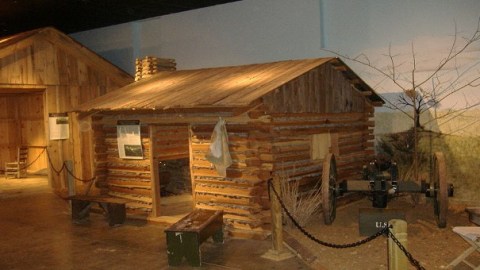Camp Nelson Brings Black Soldiers In The Civil War To Life

A week and a half ago, I found myself at Camp Nelson, which trained the third largest contingent of African American soldiers during the Civil War, the sole African American among a group of middle aged white women.
When I got the invitation to go back in March, I took one look at the cover of the brochure and was instantly ready to check “no” on the response card. Many of the narratives sustaining the fascination with the Confederacy have been tainted by generations of loser’s lament. The lust for Civil War reminiscences often goes hand in hand with a staggering level of collective amnesia about the inhuman treatment of my own enslaved forebears. So it wasn’t until I opened up the brochure and saw how extensively the inside panels referenced African American soldiers that I started to reconsider whether or not I would go to see this unique historical site.
The site itself was modest. A large, well appointed nineteenth century home that served as officer’s quarters during the war and the cemetery were the most prominent artifacts on the premises, since the camp itself, built on land rented from Kentucky landowners, was dismantled soon after the war ended so the famers could return to their homesteads. The site’s interpretive center occupied a barn-like structure less than a hundred yards behind the house. The archeologist on staff, who has excavated some of the artifacts in the center himself, was intimately familiar with the history of the camp.
It was about halfway through the short film the archeologist had turned on that the phrase “African Americans”, repeated over and over by the black narrator as he gave a condensed account of Camp Nelson’s history, began to bore into my consciousness. We moved on into the heart of the center and the archeologist took over as we all stood around a dining table sized diorama depicting the layout of the camp in the 1860’s. There was a level of disembodiment in his manner as he casually pointed out the barracks where “the African Americans” lived. With a well practiced gesture he motioned towards the gate as he told us “the African American women and children”, many of them family members of the black Union soldiers, were forced to leave the camp one brutal winter when they had no place else to go.
During a natural pause in his monologue, after another few dozen recitations of “African Americans” and “former slaves”, the archeologist looked at me through his glasses as a few of the ladies leaned over the plexiglass covering the diorama to get a closer look at the miniature structures. I can’t remember exactly what he said now, but it was obvious from his expression that he understood reason for the faraway look in my eyes.
I don’t think any of us on the tour for the first time had expected anything this detailed and well catalogued. As we wandered around the room, you could see in a lot of the recreations just how important these black troops were to Camp Nelson’s operation. I paused for a long time at a life size depiction of two black soldiers sitting in front of a camp fire. The woman who’d sat at my dinner table the night before was peering inside the recreation of a typical barrack that housed colored troops and their families with a frown on her face. She had done the math, she said, dividing the number of African Americans mentioned in the presentation by the number of dwellings that had been built. “I don’t see how they did it.”
It was the collage of pictures mounted on the wall, a few framed pictures of the type and style African Americans of the time were likely to possess that hit me square in my gut. Another woman stopped to look at the same pictures. “This place is incredible,” she said.
“We have this same type of picture at home,” I said. “It’s the exact same frame.”
I didn’t have to be worried about the drumbeat of the phrase “African American” during the second part of the tour through the officer’s quarters. “This is where the slaves would bring the food from the kitchen.” “This wall isn’t straight because the slaves who built them had to do the best they could with what they had.” “This is probably where the slaves slept.”
I was slaved out by the time the whole thing was over.
But I was glad I went. And the women in my group, who I have been briefly acquainted with over the last year or so, were as animated as I’ve ever seen them, as if they had all discovered the missing clues from a favorite whodunit whose ending they could never get to make any sense.
More importantly, I think Camp Nelson should be a required stop for my Southern contemporaries who yearn for the days of Dixie. For those who are waiting for the South to rise again, I would recommend a week-long stay.





